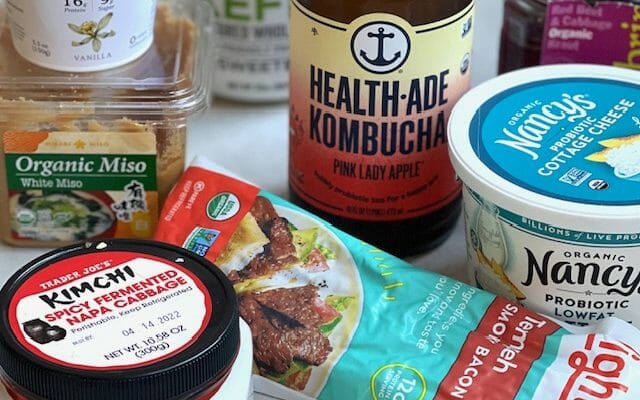8 Fermented Foods For a Healthy Gut

Fermented foods are nothing new. Cultures across the globe have used the fermentation process to preserve their precious foodstuffs for generations. What is new, however, is a growing body of research pointing to the health benefits of these foods. They’re brimming with good-for-you bacteria, otherwise known as probiotics. These living microorganisms play a key role in digestion and present a wealth of other potential upsides, from supporting the immune system to fighting inflammation. There are even studies that suggest fermented foods may impact mood and mental health, though more research is needed. Fermentation also has the potential to increase the levels and improve bioavailability of certain nutrients, such as vitamin B-12 and vitamin C. All of this AND these foods add flavor, vibrancy, and interest to your plate. Here are 8 fermented foods for a healthy gut to get you started.
8 Fermented Foods for a Healthy Gut

Yogurt
Good quality yogurt is a tasty way to get your fermented fix. Try finding a brand with the “live and active cultures” mark on the label (or another indicator that it’s brimming with bacteria). This Yogurt Sundae with Melted Raspberries is a favorite recipe, as is this Wild Blueberry Yogurt Parfait.

Miso
If you’ve yet to discover the magic of miso, this is your chance. To get the most probiotic benefits, use it in preparations that don’t involve high heat, since that will destroy those live bacteria. Everyone seems to love this Carrot Miso Dressing and this versatile Apple Cider Miso Dressing. I’m personally crazy about the Miso Butter on this Roasted Cabbage and these Easy Noodles with Peanut Sauce are a real kid-pleaser.

Cultured Cottage Cheese
Look for cottage cheese with the word “cultured” or “probiotics” on the label. Good Culture and Nancy’s are two brands to keep any eye out for. Enjoy it however you like, from a big spoonful on your salad, as a source of protein in your smoothie, or scooped up with veggies or crackers for a snack. I’m hooked on this Easy Cottage Cheese Dip and I’m always up for a good Cottage Cheese Toast.

Kombucha
Kombucha is one of the easiest ways to get in those good bacteria, but it’s not exactly cheap. I typically divide a bottle into two servings, look for it on sale, and buy it at discount shops, such as Costco. Drink it straight up or use it as part of a kombucha mocktail, such as this one I created for Better Homes and Gardens.

Fermented Vegetables
Your typical shelf-stable pickles and sauerkraut are heat treated, which knocks out the bad, as well as the good bacteria. Look to the refrigerated section of your market for probiotic-rich pickles, pickled peppers, mixed vegetable pickles, and pickled cabbage/sauerkraut. Layer them on sandwiches, add to wraps, nestle them alongside your salads, dice into chicken or tuna salad, or pile them onto tacos like these Delicata Squash, Slow Cooker Lentil or Crispy Avocado taco

Tempeh
Tempeh is made of fermented soy beans and delivers both protein and fiber. You can buy it plain or in ready-to eat flavors, such as this smoky bacon version. If it’s new to you, I wrote a whole post about it which you can find here. And these Eggplant and Tempeh Meatballs are one of the tastiest ways to eat it. You’ll also find a whole round-up of tempeh recipes by heading here.

Kefir
Kefir is creamy and tangy, tastes a bit like a yogurt drink, and is available both plain and fruit flavored. You can drink it straight up, pour it over granola, use it in place of buttermilk in salad dressing, or add it to smoothies (like this Carrot Mango Ginger drink or this creamy Strawberry Kefir Smoothie). You won’t get the same probiotic benefits using it in these pancakes, but the recipes gives you one more reason to keep kefir in your fridge.

Kimchi
This staple of the Korean table is packed with flavor and heat. I like to chop it up and add it to scrambled eggs, fried rice, tacos, Asian rice bowls, in Kimchi Grilled Cheese and Instant Pot Korean Beef Tacos. If you want to make your own kimchi, here’s a good place to start.
More Fermented Foods
In addition to these 8 fermented foods, options that may be a little less familiar are natto, gochujang, and Asian fish sauce. You can also derive probiotic benefits from preserved lemons (easy recipe here!).
For more on fermented foods, check out this post I wrote on the subject a while back.





Comments